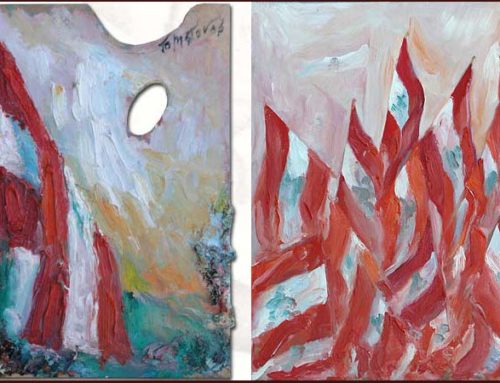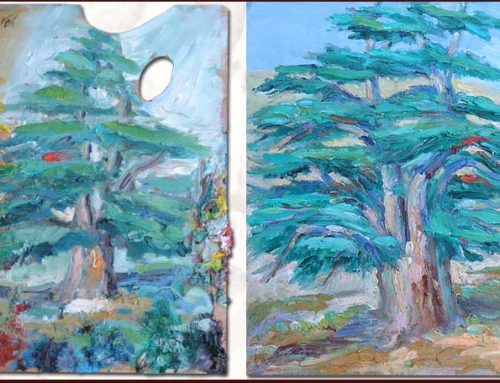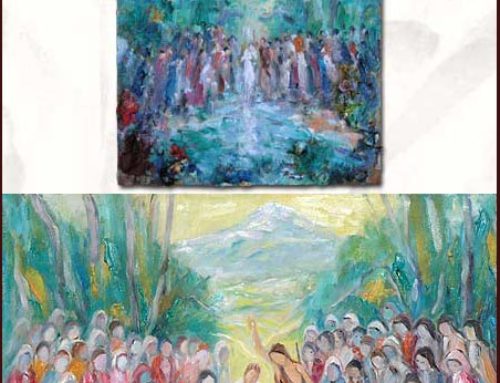Away from the Humdrum
From many and varied works you are offered a choice. In this show four or even more themes dominating the activities of this painter are revealed: ideas, sentiments, concepts, loves and dreams that permeate his soul and his universe.
Any work of art is an interior play which has taken material form on some support such as canvas, a play involving that which is conscious and that which is unconscious. The work which an artist puts before your eyes makes its appeal on several levels; there is the subject which is treated, the manner of treatment, the soul of its creator, the play of colors, the richness of expression, and finally the power of communication.
What do we mean by a theme? Can there be a subject for a work of art? The real subject is the artist himself, his breath, his style. To speak of schools, of styles and various “isms” is just so much empty consumerism. To speak of new techniques, new methods, new materials and novelties is all very well as far as it goes, and as so much phraseology. The important thing is for the new introductions to be fully mastered by the creative genius and all organized into the output expressed in the work, in such a way as to reach public acceptance. To mix art up with philosophy and literature might have its uses but can sometimes verge on the ridiculous.
The arts have mutual relationships that can sometimes be done without. In short, a work of art sometimes links up with poetry with or without the muses. What finally counts are the means, the mastery, the knowledge, the love, the will, and last but not least the imprint of the creator’s soul. But is there not also the question of Why? Why strive in one particular field rather than another? What drives the artist to work? What is this flame that burns? And what of those dreams in the night of Elysian fields, those trees from which stars are plucked, fruits of gold?
The how and the why are bound up with the artist, his way of being, of acting, of breathing, of loving, and of living. All this must be taken into account in order that that this surface may cease under the inspiration of the artist to be an empty space but instead a presence vibrant with life, force, and poetry.
1) So we have the theme of exodus, of departure, one which is by no means new. It treats of something which has existed since the dawn of time in the form of emigration, the movement of masses, of tribes, of displaced peoples, from one settlement to another. We think of this leaving one’s self, this departure, wandering, and breaking of monotony, in a search for some promised lands, for a dream, escaping the desert stretches of one’s life. This means the passage from one state of mind to another in the quest for the light of a luminous star, like that of the Wise Men as related in the second chapter of the Gospel of Matthew.
Stagnation, endless waiting, routine, all these exhaust one’s vitality and creativity. One has to be always on the look-out for something new. Going forward and coming back are both one and the same act but seen from two different aspects. There is the same movement, the same rush, and a human swarm that moves, flees, or emigrates. Exodus is the word which can cover all these different activities.
2) There is a second theme, that of the eternal nights which envelop us, fear, withdrawal, and also the mysteries. It is impossible to isolate the nights of dreams and meditation which have taken up half of our lives. We are lost in dark labyrinths peopled by other creatures that inspire either love or horror, with fantastic tales and legends and varied loves.
But the impenetrable darkness beats a retreat and in the distance there are always those luminous swirls where a divine hand traces circles of light guided by Wisdom.
3) Once again it is the Light which bursts forth with all its force in every direction and which cannot be held back. It is joy, hope, splendor, the great universal cosmic feast, the sacred springtime, rhythmic, intimate, sensual and transparent which well up from the depths of the soul like a rainbow nebula. Are there no other horizons in other galaxies with forms and shining lights? See the first chapter of Genesis and the thirty-eighth chapter of the Book of Job. Did not the Creator bring about circles, ovals, galactic shapes, and expanding clouds of stars? He relates, He writes, He sets up, He creates history and stories in our Holy Scripture, as in Proverbs 8: 22-37 – “What? But have you not read?” Mark 2: 25.
Was not Le Petit Prince of Saint-Exupéry a tale written for children with the intention that grown-ups should read it? Were the characters that appear in the Last Judgment of Michelangelo thrown in at random or rather according to studied structure, distribution, order and plans full of meaning? Do this circular orb, so enigmatic and vertiginous, and this mysterious vault of heaven lead to an apocalyptic end? What escapes there are from this tunnel, towards what liberty, deliverance, success, hope, adventure, and flight, what immense orbs that are the wonder of every astrophysicist!
The origin of all these processes is an assembly of realities which have taken part in the creation of a work whose elements have a direct relationship and harmonize, draw together, or repel each other to finally present a homogeneous work recalling the first mornings of creation. One can always see therein the imprint of the hands of the Divine Creator who molded it. A new aspect of the world is offered with a tree, a house, a flower, a crowd, a group, an emotion, or even with a jocular scene such as Picasso delineated or as Dürer or Breughel drew.
4) It offers also the theme of communion, the silent participation in a feast which becomes spiritual. When there is a dish bearing the Solar Spirit, participation means receiving, exchanging, taking or giving, with full knowledge, richness, love and happiness – and is not this a choice part of civilization? This mystery of communion means welcoming, accepting and loving others. (John 2: 1) All this was seen at the marriage at Cana (John 12: 1), at the Last Supper (John 13: 2), and at the one standing for the Kingdom of Heaven (Matthew 22: 2).
Here then are some aspects of his pictured universe where the artist shows himself luminous, sincere, authentic and welcoming in a variety of works on daily life, portraits, landscapes, scenes of flowers, houses and verdant slopes from our mountains, a scene of life whether welcoming or austere that with varied colors charms the eyes.
One cannot praise or thank Mr. Abdallah Dadour enough for the welcome he has extended to artists that they may present there works at Surface Libre (Free Surface) with such a diversity of talent, expression, message, emotion and effort.
Jean De Lalande
Translation from the French: Kenneth Mortimer







